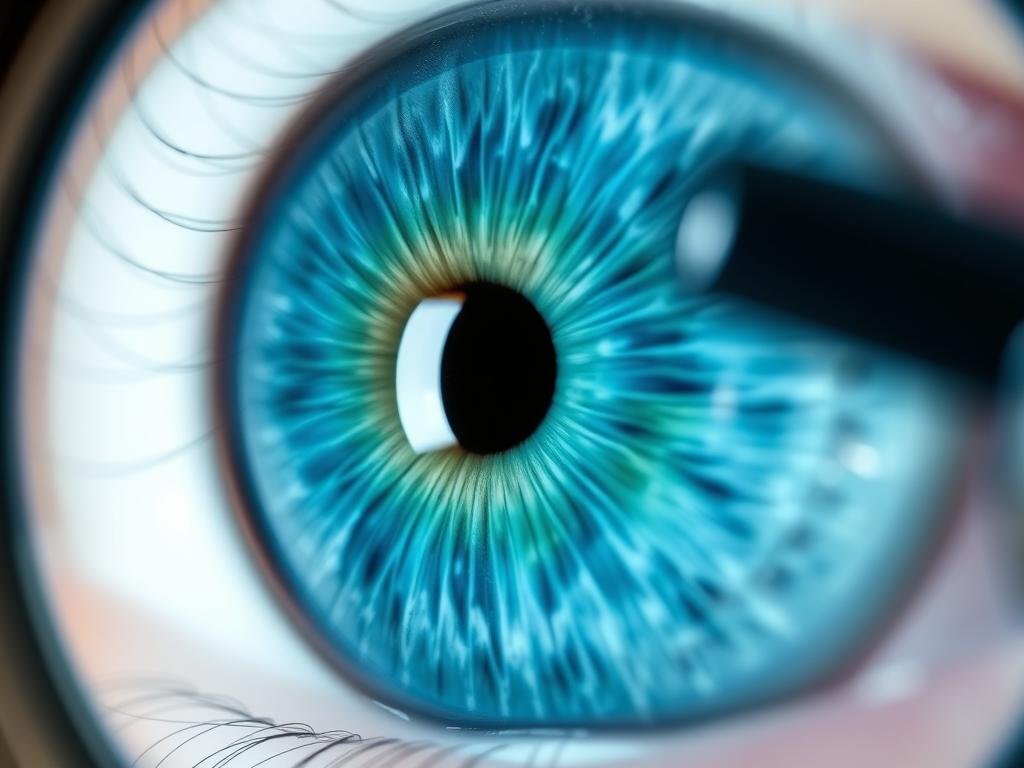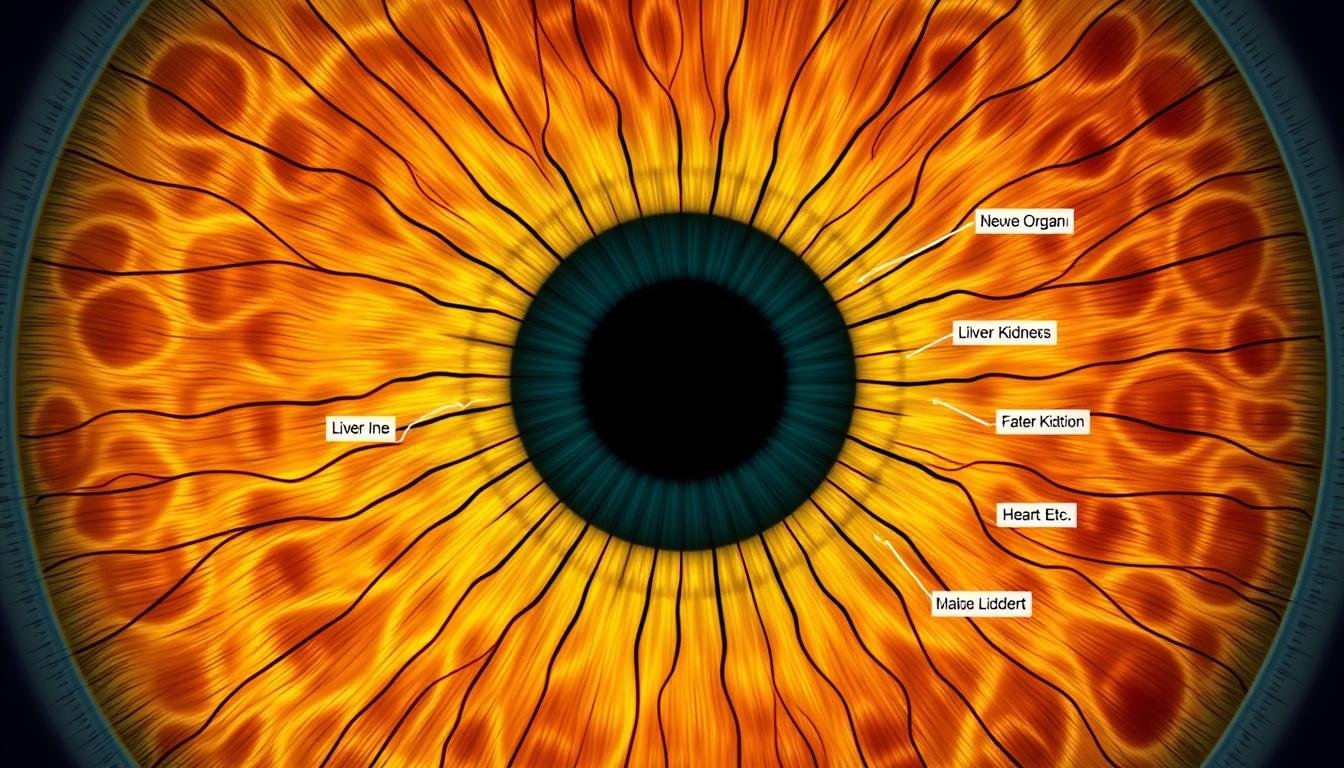What is Iridologie?
Iridologie is a holistic practice that analyzes patterns, colors, and other characteristics of the iris to identify potential health concerns throughout the body. Practitioners believe that each area of the iris corresponds to specific organs and body systems, creating a map that can reveal information about a person’s health status.
An iridology chart mapping different regions of the iris to specific organs and body systems
The core principle of iridologie suggests that the iris contains an intricate network of nerve endings connected to various parts of the body through the nervous system. According to iridologists, changes in these tissues reflect in the iris, potentially revealing inflammation, toxin accumulation, or organ dysfunction before symptoms become apparent.
Curious About Your Eye Health?
While exploring alternative approaches like iridology, it’s important to maintain regular eye health checkups with qualified professionals.
Schedule a Comprehensive Eye Exam
The History and Origins of Iridologie
The concept of examining the eyes for health insights dates back thousands of years, with some evidence suggesting early practices in ancient Egypt, China, and India. However, modern iridologie as we know it today began to take shape in the 19th century.

Ignaz von Peczely, the Hungarian physician considered the father of modern iridology
Key Figures in Iridologie‘s Development
Ignaz von Peczely (1826-1911)
The Hungarian physician Ignaz von Peczely is widely recognized as the “father of iridology.” According to popular accounts, as a child, von Peczely noticed a dark streak in an owl’s iris after the bird suffered a broken leg. This observation sparked his interest in the connection between iris markings and physical injuries or conditions.
Von Peczely later developed the first comprehensive iris chart in 1881, mapping specific areas of the iris to corresponding body organs and systems. His work, “Discoveries in the Field of Natural Science and Medicine: Instruction in the Study of Diagnosis from the Eye,” laid the foundation for modern iridology practice.
Bernard Jensen (1908-2001)
In the United States, chiropractor Bernard Jensen significantly advanced the practice of iridology in the mid-20th century. Jensen studied under various European iridologists and developed his own detailed iris chart in the 1950s, which remains influential today.
Jensen emphasized the connection between nutrition, detoxification, and health, integrating iridology into a broader approach to natural healing. His books and teachings helped popularize iridology in North America and established many of the principles still followed by contemporary practitioners.
Throughout the 20th century, iridology continued to evolve with contributions from practitioners around the world, particularly in Europe where it gained significant following in countries like Germany, Russia, and the United Kingdom.
How Iridologie Claims to Work
Iridologists believe they can assess health conditions by examining specific changes in the iris’s appearance. The practice is based on several key principles:

Detailed examination of iris patterns during an iridology assessment
- Iris Mapping: Each section of the iris supposedly corresponds to a specific organ or body system, creating a “carte” that practitioners use for diagnosis.
- Tissue Changes: Changes in iris fibers, colors, and patterns are believed to reflect changes in corresponding body tissues.
- Constitutional Assessment: The basic structure and color of the iris are thought to indicate genetic predispositions and inherent strengths or weaknesses.
- Toxin Accumulation: Dark spots or marks may indicate toxin buildup in specific organs or systems.
Le Iridologie Examination Process
A typical iridology examination involves several steps:

An iridologist examining a patient’s iris with specialized equipment
- The practitioner examines the iris using specialized equipment such as a magnifying glass, penlight, or digital camera with magnification capabilities.
- Photos may be taken of both irises for detailed analysis.
- The iridologist compares the iris patterns to an iridology chart, noting any abnormalities in color, structure, or markings.
- Based on these observations, the practitioner develops an assessment of potential health issues or vulnerabilities.
- Recommendations may include dietary changes, supplements, or other lifestyle modifications.
Iridologists typically look for specific signs in the iris:
| Signe de l'iris |
Interpretation in Iridologie |
| White rings around the iris |
Possible sodium accumulation or stress |
| Taches sombres |
Potential toxin buildup in specific organs |
| Radial lines or “spokes” |
Possible inflammation or irritation |
| Color changes |
Indication of chemical imbalances or organ dysfunction |
| Lymphatic rosary (white dots in a circular pattern) |
Lymphatic system congestion |
Scientific Evidence and Criticism of Iridologie
Despite its long history and continued practice, iridologie has faced significant scientific scrutiny. Most medical professionals and researchers do not support iridology as a valid diagnostic method, citing several key concerns:

Scientific research examining the validity of iridology claims
Arguments Supporting Iridology
- Proponents cite anecdotal success stories and case studies
- Some practitioners report high satisfaction rates among clients
- Non-invasive nature makes it appealing as a screening tool
- May encourage people to be more proactive about their health
Critiques scientifiques
- Manque de lien anatomique entre l'iris et la plupart des organes du corps
- Controlled studies have failed to validate diagnostic claims
- La structure de l'iris reste largement stable tout au long de la vie
- Potential for misdiagnosis or delayed proper medical treatment
Key Research Studies
Several scientific studies have investigated the validity of iridologie:
“Iridology had no clinical or statistically significant ability to detect the presence of kidney disease. Further, results were not influenced by the iris color, the presence of specific iris signs, or the gender of the subject.”
— Study published in the Journal of Alternative and Complementary Medicine, 2000
A systematic review published in 1999 examined four controlled studies and concluded that iridology’s efficacy was not supported by scientific evaluations. Another study published in the Archives of Ophthalmology in 2000 stated that “iridology has shown to be of little benefit to anyone” and suggested that “patients and therapists should be discouraged from utilizing iridology since it has the potential to cause personal and financial harm.”
The scientific community generally points to several fundamental issues with iridology:
- Iris Stability: Research has demonstrated that the iris structure remains largely stable throughout life, except for changes due to injury or certain eye conditions.
- Lack of Physiological Mechanism: There is no established physiological mechanism that would explain how internal organ conditions would manifest as visible changes in iris tissue.
- Poor Diagnostic Reliability: Studies have shown that iridologists often reach different conclusions when examining the same iris.
Concerned About Your Health?
While exploring alternative approaches like iridology, it’s important to maintain regular checkups with healthcare professionals for evidence-based assessments.
Find a Healthcare Provider Near You
Health Conditions Iridologie Claims to Detect
Practitioners of iridologie claim the ability to identify a wide range of health conditions through iris examination. While scientific evidence doesn’t support these claims, it’s worth understanding what iridologists believe they can detect:

Comparison of iris patterns that iridologists associate with different health conditions
Problèmes digestifs
Iridologists claim to identify digestive disorders, including irritable bowel syndrome, acid reflux, and intestinal inflammation through specific markings in the corresponding iris zones.
Inflammatory Conditions
White markings or “spokes” in certain areas of the iris are interpreted as signs of inflammation in corresponding body parts, potentially indicating arthritis or other inflammatory conditions.
Accumulation de toxines
Dark spots or discolorations may be interpreted as signs of toxin buildup in specific organs, particularly the liver, kidneys, or lymphatic system.
Hormonal Imbalances
Changes in the iris sections corresponding to endocrine glands are believed to indicate hormonal issues, including thyroid dysfunction or adrenal fatigue.
Cardiovascular Issues
Certain patterns in specific iris regions are interpreted as indicators of circulatory problems, blood pressure issues, or heart weaknesses.
Stress du système nerveux
Radial lines extending from the pupil may be seen as signs of nervous system stress or neurological issues according to iridology principles.
Remarque importante: While iridologists make these claims, conventional medicine does not recognize iridology as a valid diagnostic method for these or any other health conditions. Always consult with qualified healthcare professionals for proper diagnosis and treatment of medical concerns.
Iridologie vs. Conventional Medical Diagnostics
When considering iridologie as a potential diagnostic tool, it’s important to understand how it compares to conventional medical diagnostic approaches:

Comparison between iridology examination methods and conventional medical diagnostic equipment
| Aspect |
Iridologie |
Conventional Medical Diagnostics |
| Validation scientifique |
Soutien scientifique limité; Non reconnu par la médecine grand public |
Based on extensive research and clinical trials |
| Approche diagnostique |
Observes iris patterns to infer conditions throughout the body |
Directly examines affected body systems using targeted tests |
| Equipment Used |
Magnifying devices, specialized cameras, iris charts |
Blood tests, imaging (X-rays, MRI, CT), specialized diagnostic equipment |
| Specificity |
General indications of potential issues |
Can identify specific conditions, pathogens, or abnormalities |
| Treatment Integration |
Often paired with natural remedies and lifestyle changes |
Directly informs evidence-based medical treatments |
While iridologie offers a non-invasive approach that some find appealing, conventional medical diagnostics provide measurable, specific information about health conditions that can be directly verified through multiple testing methods.
Eye Examinations in Conventional Medicine: It’s worth noting that conventional eye examinations performed by ophthalmologists and optometrists can detect certain health conditions, including diabetes, hypertension, and autoimmune disorders, through observable changes in the retina and other eye structures. These medically validated examinations differ significantly from iridology.
Finding a Qualified Iridologie Practitioner
If you’re interested in exploring iridologie despite its scientific limitations, it’s important to approach it as a complementary practice rather than a replacement for conventional medical care. Here are some considerations for finding a qualified practitioner:

A professional iridology consultation in a clinical setting
Qualifications to Look For
- Formal Training: Look for practitioners who have completed comprehensive training programs in iridology.
- Professional Certification: Some practitioners may hold certifications from iridology associations or natural health organizations.
- Additional Health Credentials: Many reputable iridologists also have backgrounds in other health fields such as naturopathy, nutrition, or traditional Chinese medicine.
- Experience: Consider the practitioner’s years of experience and client testimonials.
- Ethical Approach: Choose practitioners who do not claim to diagnose specific diseases and who encourage clients to maintain regular medical care.
Important Warning: Be wary of practitioners who claim iridology can diagnose specific diseases, recommend abandoning conventional medical treatments, or promise cures based solely on iris analysis. These claims exceed what iridology can realistically offer and may pose health risks.
Questions to Ask Before a Consultation
- What is your training and certification in iridology?
- Do you have other health or medical qualifications?
- What can I realistically expect from an iridology session?
- How do you integrate iridology with conventional medical care?
- What types of recommendations do you typically make based on iris analysis?
Interested in Learning More About Eye Health?
Whether you’re curious about iridology or conventional eye care, understanding your options is important for making informed health decisions.
Explore Eye Health Resources
Frequently Asked Questions About Iridologie
Is iridologie recognized by conventional medicine?
No, iridology is not recognized as a valid diagnostic method by conventional medicine. Major medical organizations, including the American Medical Association and the American Academy of Ophthalmology, do not endorse iridology due to the lack of scientific evidence supporting its claims.
Can iridologie detect cancer or other serious diseases?
There is no scientific evidence that iridology can detect cancer or other serious diseases. Controlled studies have failed to demonstrate that iridologists can accurately identify patients with known medical conditions through iris examination. Relying solely on iridology for detecting serious conditions could lead to delayed diagnosis and treatment.
Is iridologie covered by health insurance?
Most health insurance plans do not cover iridology sessions as they are considered alternative or complementary practices without sufficient scientific validation. Some flexible spending accounts (FSAs) or health savings accounts (HSAs) might allow for these expenses, but you should check with your specific plan administrator.
How much does an iridologie session typically cost?
The cost of an iridology session varies widely depending on location, practitioner experience, and session length. Prices typically range from to 0 for an initial consultation, with follow-up sessions often costing less. Some practitioners may include iridology as part of a broader natural health assessment.
Can I practice iridologie on myself?
While there are books and online resources about self-iridology, practitioners generally advise against self-diagnosis. Proper iris analysis requires specialized equipment and training to interpret the complex patterns and markings. Additionally, it’s difficult to objectively examine your own iris in sufficient detail.

Many people research iridology online before deciding whether to pursue a consultation
Conclusion: Is Iridologie Worth Exploring?
Iridologie remains a controversial practice in the health and wellness landscape. While its proponents believe in its value as a holistic assessment tool, the scientific community has not found sufficient evidence to support its diagnostic claims.

Many individuals choose to incorporate both alternative and conventional approaches to health
If you’re considering iridologie, it’s important to:
- Maintain Realistic Expectations: Approach iridology as a complementary practice rather than a definitive diagnostic method.
- Continue Conventional Medical Care: Do not substitute iridology for regular check-ups and evidence-based medical care.
- Research Practitioners Carefully: If you choose to explore iridology, select practitioners with proper training and an ethical approach.
- Consider the Evidence: Be aware of the scientific limitations and lack of validation for iridology’s claims.
Ultimately, the decision to explore iridologie is personal. While it may offer some individuals a different perspective on their health, it should be approached with a critical mind and as part of a broader health strategy that includes evidence-based medical care.
Take Charge of Your Health Journey
Whether you’re interested in alternative approaches like iridology or conventional medicine, staying informed helps you make the best decisions for your health.
Explore Comprehensive Health Resources
























